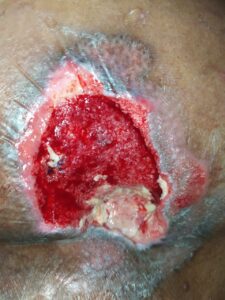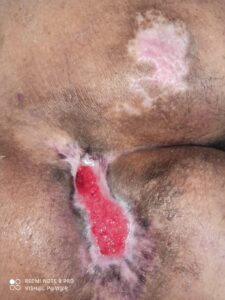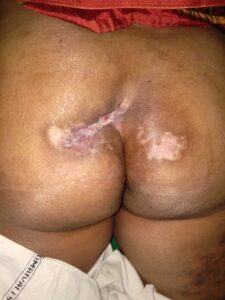Pressure Sore
Abou Pressure Sore

Sacral pressure sore

After debridement & Two sessions of VAC therapy

Wound completely healed
Pressure sores, or bedsores, can develop if a person spends a long time in the same position.
Causes
Anyone who stays in one position for a long time is at risk. Trusted Source of developing pressure sores. They often form in people who need help changing positions.
A person who develops a pressure sore may:
- spend a lot of time sitting in a chair or lying in bed(Stroke,Paraperesis,Post Surgery)
- wear a prosthesis or surgical appliance
- wear ill-fitting shoes or clothing with elastic
- These sores form when tissues and blood vessels become compressed, then distorted. This can lead to poor circulation, resulting in tissue death & necrosis of skin & subcutaneous tissue.
- Sores can result from significant pressure over a short period or low pressure over a longer period.
Prevention
Tips for reducing the risk of pressure sores include:
Changing positions frequently, between every 15 minutes to every 2 hours, depending on a person’s needs
- Inspecting the skin every day
- keeping the skin clean and dry
- maintaining good nutrition
- quitting smoking
- doing exercises, even while in bed, to encourage circulation
- Anyone who may have a pressure sore should notify their caregiver or a healthcare professional as soon as possible.
Pressure sores develop in four stages:
- The skin feels warm to the touch. There may be a colour change, such as redness, and the area may be itchy.
- A painful open sore or blister develops, with discoloured skin around it.
- The lesion develops a crater-like appearance, due to tissue damage below the skin’s surface.
- There is severe damage to the skin and tissue, possibly with an infection. The muscles, bones, and tendons may be visible.
An infected sore takes longer to heal. The infection can spread elsewhere in the body and cause significant harm.
Treatment
Frequently changing positions can help the sores heal and keep new ones from forming. Other specific measures depend on the stage of the sore. One Should Consult a Plastic Surgeon for treatment.
Acute Bed Sores
Generally, require Debridement of wound include removing dead tissue, cleaning the wound. Good nursing care & control of infection
A person with bedsores may also benefit from:
- vacuum-assisted wound closure
- electrical stimulation
- hyperbaric oxygen therapy.
Depending on the wound surgeon would decide appropriate options. Sometimes may need Skin Grafting, Flap Surgery for treating Bed Sores.
Chronic Bed Sores
These are very difficult to treat. Treatment is debridement of bedsore & flap surgery. Lifestyle modification to avoid pressure over that area for avoiding further recurrence.
